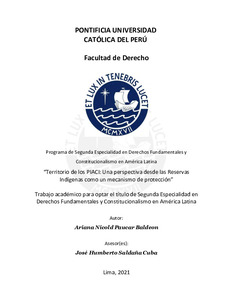| dc.contributor.advisor | Saldaña Cuba, José Humberto | |
| dc.contributor.author | Paucar Baldeon, Ariana Nicold | |
| dc.date.accessioned | 2022-03-22T23:44:49Z | |
| dc.date.available | 2022-03-22T23:44:49Z | |
| dc.date.created | 2021 | |
| dc.date.issued | 2022-03-22 | |
| dc.identifier.uri | http://hdl.handle.net/20.500.12404/21869 | |
| dc.description.abstract | En el Perú, la historia de los pueblos indígenas se invisibiliza constantemente; sin embargo,
resalta la presencia de los mismos ante la posibilidad del desarrollar de actividades
extractivas en sus territorios, pese a ello, dicha situación genera afectaciones sistemáticas a
derechos como el territorio y la vida. Los derechos mencionados previamente, requieren
especial atención si se considera, considerando que muchos de los espacios que ocupan
carecen de protección. En ese sentido, las Reservas indígenas se presentan como el
mecanismo idóneo para salvaguardar los derechos de la población en aislamiento y en
contacto inicial junto con sus derechos.
Conforme el Convenio 169, el territorio es entendido como la totalidad del hábitat de las
regiones que los pueblos interesados ocupan o utilizan de alguna otra manera, además, se
caracteriza por estar habitado de manera ancestral por dicha población, por lo que debe ser
respetado y protegido junto con la libre autodeterminación de los pueblos de permanecer en
la situación de aislamiento y de contacto inicial, por lo que se resalta la creación de Reservas
Indígenas para la defensa de derechos de los PIACI. Por último, es preciso evaluar el accionar
del Estado frente las actividades extractivas plasmadas en contratos ley en aplicación del
control de convencionalidad, tomando en cuenta el impacto de la jurisprudencia de la Corte
IDH en cuanto protección de los pueblos indígenas del Perú. | es_ES |
| dc.description.abstract | In Peru, the history of indigenous peoples is constantly being made invisible; however, their
presence stands out due to the possibility of carrying out extractive activities in their
territories, despite this, this situation generates systematic effects on rights such as territory
and life. The aforementioned rights require special attention if it is considered, considering
that many of the spaces they occupy lack protection. In this sense, the Indigenous Reserves
are presented as the ideal mechanism to safeguard the rights of the population in isolation
and in initial contact together with their rights.
According to Convention 169, the territory is understood as the totality of the habitat of the
regions that the interested peoples occupy or use in some other way, in addition, it is
characterized by being inhabited in an ancestral way by said population, so it must be respected and protected together with the free self-determination of the peoples to remain in
the situation of isolation and initial contact, which is why the creation of Indigenous Reserves
for the defense of the rights of the PIACI is highlighted. Finally, it is necessary to evaluate
the actions of the State in the face of extractive activities embodied in legal contracts in
application of conventionality control, taking into account the impact of the jurisprudence of
the Inter-American Court regarding the protection of the indigenous peoples of Peru. | es_ES |
| dc.language.iso | spa | es_ES |
| dc.publisher | Pontificia Universidad Católica del Perú | |
| dc.rights | info:eu-repo/semantics/openAccess | es_ES |
| dc.rights.uri | http://creativecommons.org/licenses/by/2.5/pe/ | * |
| dc.subject | Pueblos indígenas--Perú | es_ES |
| dc.subject | Tierras--Legislación--Perú | es_ES |
| dc.subject | Derecho indígena | es_ES |
| dc.subject | Tenencia de la tierra--Perú | es_ES |
| dc.title | Territorio de los PIACI: Una perspectiva desde las Reservas Indígenas como un mecanismo de protección | es_ES |
| dc.type | info:eu-repo/semantics/bachelorThesis | es_ES |
| thesis.degree.name | Segunda Especialidad en Derechos Fundamentales y Constitucionalismo en América Latina | es_ES |
| thesis.degree.level | Título Profesional | es_ES |
| thesis.degree.grantor | Pontificia Universidad Católica del Perú. Facultad de Derecho | es_ES |
| thesis.degree.discipline | Derechos Fundamentales y Constitucionalismo en América Latina | es_ES |
| renati.advisor.dni | 44307054 | |
| renati.advisor.orcid | https://orcid.org/0000-0003-0890-3899 | es_ES |
| renati.author.dni | 72488813 | |
| renati.discipline | 421189 | es_ES |
| renati.level | https://purl.org/pe-repo/renati/level#tituloSegundaEspecialidad | es_ES |
| renati.type | https://purl.org/pe-repo/renati/type#trabajoAcademico | es_ES |
| dc.publisher.country | PE | es_ES |
| dc.subject.ocde | https://purl.org/pe-repo/ocde/ford#5.05.01 | es_ES |






